fuel SAAB 9-3 2001 Owners Manual
[x] Cancel search | Manufacturer: SAAB, Model Year: 2001, Model line: 9-3, Model: SAAB 9-3 2001Pages: 260, PDF Size: 12.01 MB
Page 3 of 260
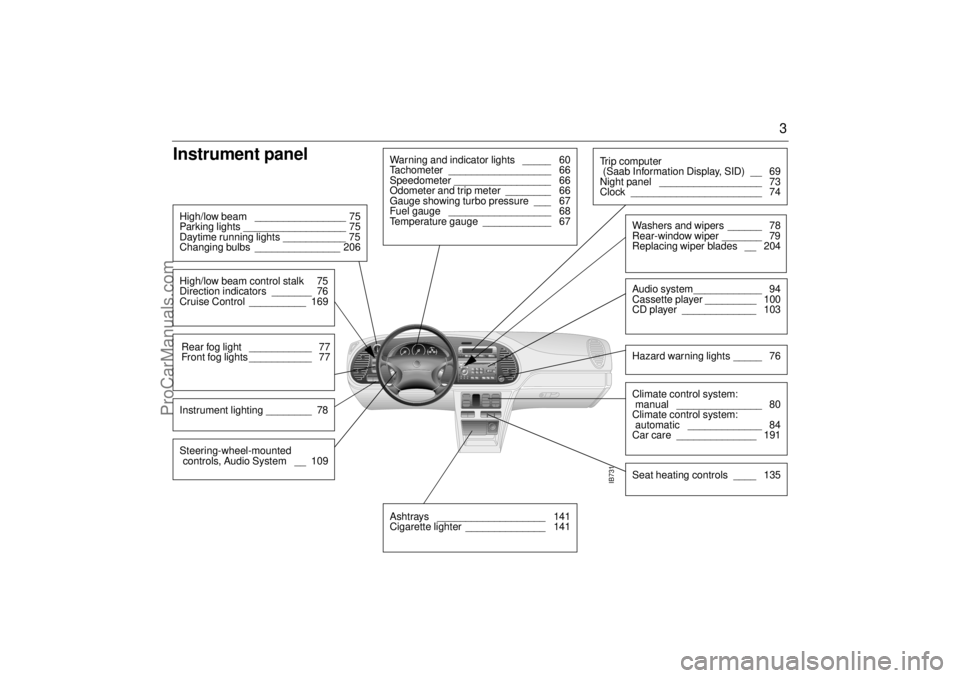
3
Instrument panel High/low beam ________________ 75
Parking lights __________________ 75
Daytime running lights ___________ 75
Changing bulbs _______________ 206High/low beam control stalk 75
Direction indicators _______ 76
Cruise Control __________ 169Rear fog light ___________ 77
Front fog lights ___________ 77Instrument lighting ________ 78
Warning and indicator lights _____ 60
Tachometer __________________ 66
Speedometer _________________ 66
Odometer and trip meter ________ 66
Gauge showing turbo pressure ___ 67
Fuel gauge __________________ 68
Temperature gauge ____________ 67
IB731
Ashtrays ___________________ 141
Cigarette lighter ______________ 141
Tr i p c o m p u t e r
(Saab Information Display, SID) __ 69
Night panel __________________ 73
Clock _______________________ 74
Washers and wipers ______ 78
Rear-window wiper _______ 79
Replacing wiper blades __ 204Audio system____________ 94
Cassette player _________ 100
CD player _____________ 103Hazard warning lights _____ 76Climate control system:
manual _______________ 80
Climate control system:
automatic _____________ 84
Car care ______________ 191Seat heating controls ____ 135
Steering-wheel-mounted
controls, Audio System __ 109
ProCarManuals.com
Page 4 of 260
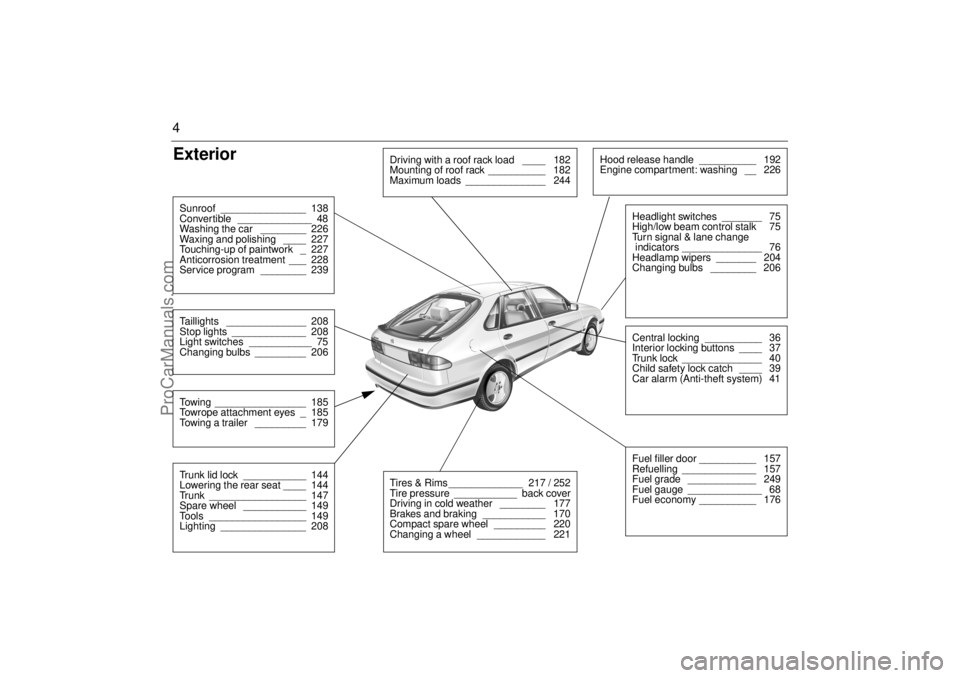
4Exterior Sunroof _______________ 138
Convertible _____________ 48
Washing the car ________ 226
Waxing and polishing ____ 227
Touching-up of paintwork _ 227
Anticorrosion treatment ___ 228
Service program ________ 239Taillights ______________ 208
Stop lights _____________ 208
Light switches ___________ 75
Changing bulbs _________ 206Towing ________________ 185
Towrope attachment eyes _ 185
Towing a trailer _________ 179Trunk lid lock ___________ 144
Lowering the rear seat ____ 144
Trunk _________________ 147
Spare wheel ___________ 149
Tools _________________ 149
Lighting _______________ 208
Driving with a roof rack load ____ 182
Mounting of roof rack __________ 182
Maximum loads ______________ 244
Hood release handle __________ 192
Engine compartment: washing __ 226
Central locking __________ 36
Interior locking buttons ____ 37
Trunk lock ______________ 40
Child safety lock catch ____ 39
Car alarm (Anti-theft system) 41Headlight switches _______ 75
High/low beam control stalk 75
Turn signal & lane change
indicators ______________ 76
Headlamp wipers _______ 204
Changing bulbs ________ 206Fuel filler door __________ 157
Refuelling _____________ 157
Fuel grade ____________ 249
Fuel gauge _____________ 68
Fuel economy __________ 176
Tires & Rims _____________ 217 / 252
Tire pressure ___________ back cover
Driving in cold weather ________ 177
Brakes and braking ___________ 170
Compact spare wheel _________ 220
Changing a wheel ____________ 221
ProCarManuals.com
Page 47 of 260
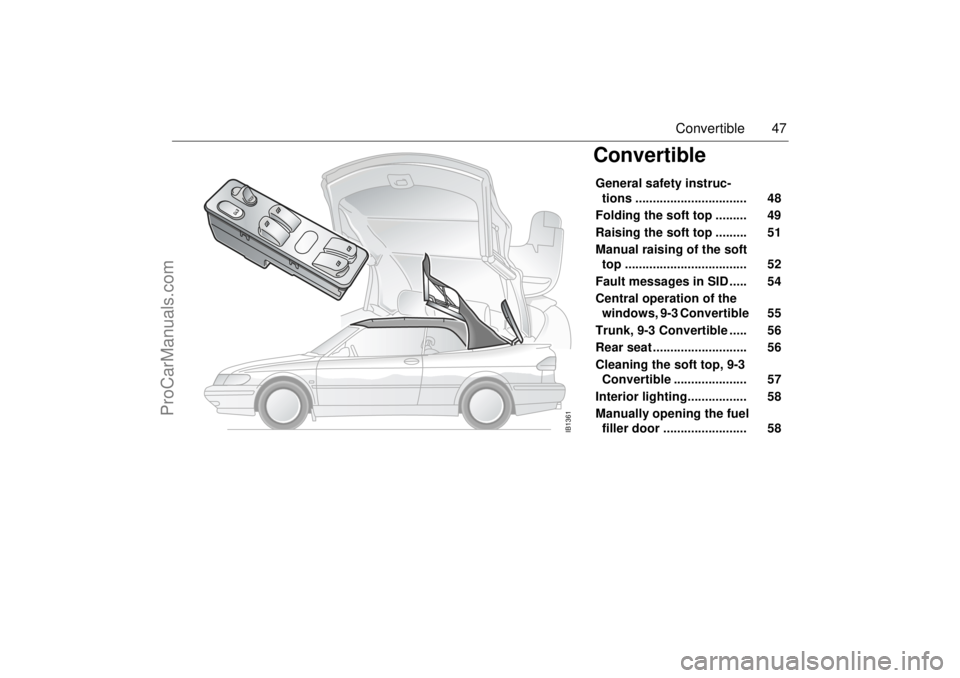
47 Convertible
ConvertibleGeneral safety instruc-
tions ................................ 48
Folding the soft top ......... 49
Raising the soft top ......... 51
Manual raising of the soft
top ................................... 52
Fault messages in SID ..... 54
Central operation of the
windows, 9-3 Convertible 55
Trunk, 9-3 Convertible ..... 56
Rear seat ........................... 56
Cleaning the soft top, 9-3
Convertible ..................... 57
Interior lighting................. 58
Manually opening the fuel
filler door ........................ 58
IB1361
ProCarManuals.com
Page 58 of 260
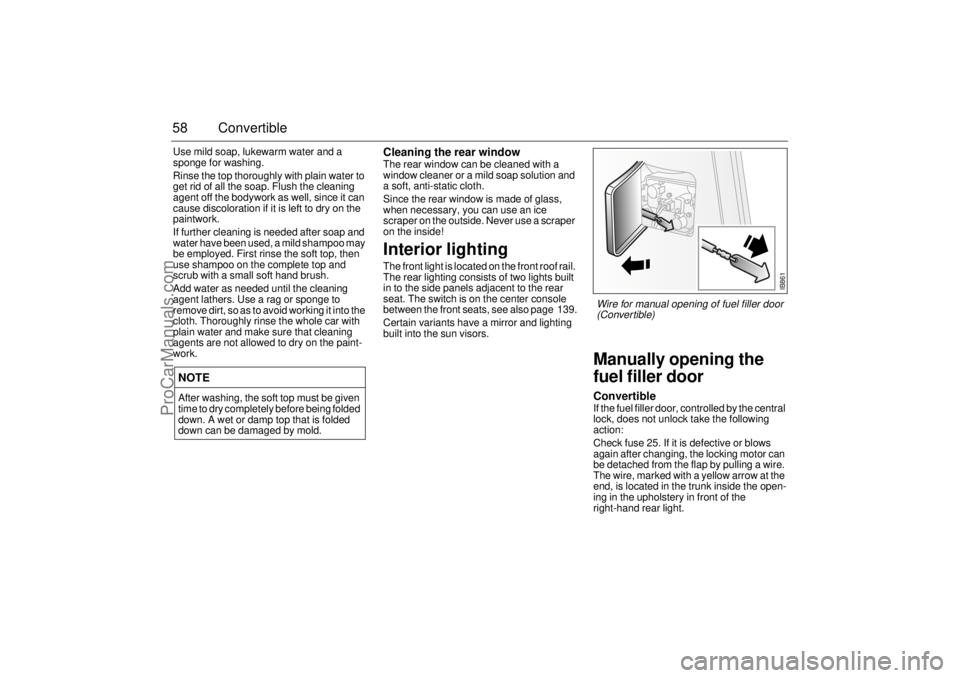
58 ConvertibleUse mild soap, lukewarm water and a
sponge for washing.
Rinse the top thoroughly with plain water to
get rid of all the soap. Flush the cleaning
agent off the bodywork as well, since it can
cause discoloration if it is left to dry on the
paintwork.
If further cleaning is needed after soap and
water have been used, a mild shampoo may
be employed. First rinse the soft top, then
use shampoo on the complete top and
scrub with a small soft hand brush.
Add water as needed until the cleaning
agent lathers. Use a rag or sponge to
remove dirt, so as to avoid working it into the
cloth. Thoroughly rinse the whole car with
plain water and make sure that cleaning
agents are not allowed to dry on the paint-
work.
Cleaning the rear windowThe rear window can be cleaned with a
window cleaner or a mild soap solution and
a soft, anti-static cloth.
Since the rear window is made of glass,
when necessary, you can use an ice
scraper on the outside. Never use a scraper
on the inside!Interior lightingThe front light is located on the front roof rail.
The rear lighting consists of two lights built
in to the side panels adjacent to the rear
seat. The switch is on the center console
between the front seats, see also page 139.
Certain variants have a mirror and lighting
built into the sun visors.
Manually opening the
fuel filler doorConvertible If the fuel filler door, controlled by the central
lock, does not unlock take the following
action:
Check fuse 25. If it is defective or blows
again after changing, the locking motor can
be detached from the flap by pulling a wire.
The wire, marked with a yellow arrow at the
end, is located in the trunk inside the open-
ing in the upholstery in front of the
right-hand rear light.
NOTEAfter washing, the soft top must be given
time to dry completely before being folded
down. A wet or damp top that is folded
down can be damaged by mold.
IB861
Wire for manual opening of fuel filler door
(Convertible)
ProCarManuals.com
Page 60 of 260
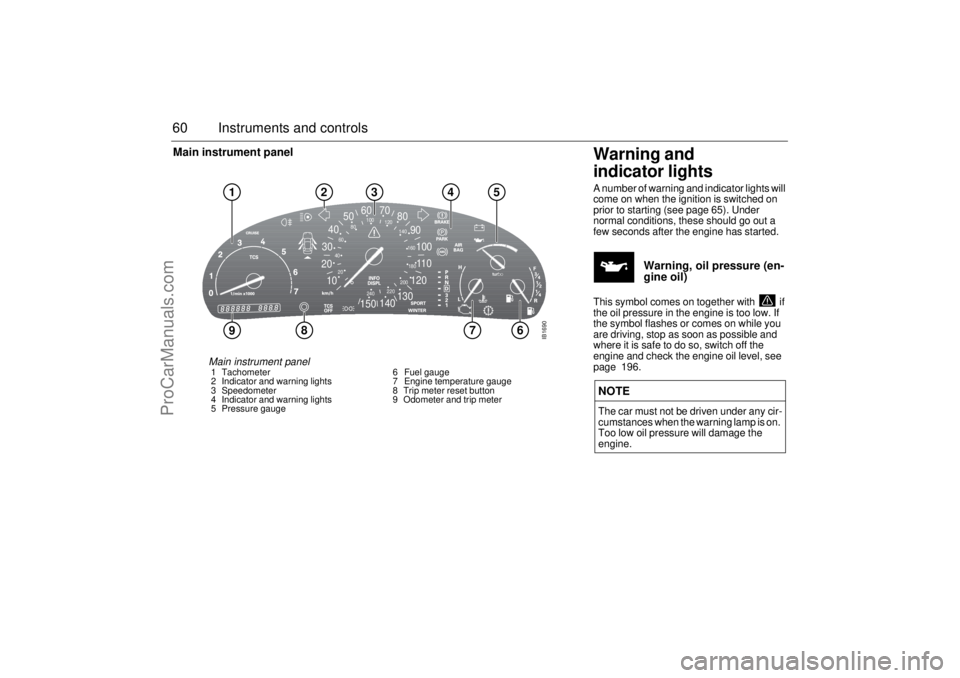
60 Instruments and controlsMain instrument panel
Warning and
indicator lightsA number of warning and indicator lights will
come on when the ignition is switched on
prior to starting (see page 65). Under
normal conditions, these should go out a
few seconds after the engine has started.
Warning, oil pressure (en-
gine oil)
This symbol comes on together with if
the oil pressure in the engine is too low. If
the symbol flashes or comes on while you
are driving, stop as soon as possible and
where it is safe to do so, switch off the
engine and check the engine oil level, see
page 196. NOTEThe car must not be driven under any cir-
cumstances when the warning lamp is on.
Too low oil pressure will damage the
engine.
2030405060 70
80
90
100
11 0
120
130
140
150
240220200180 160 140 120 100
80
60
40
20
10
9
4
5
3
2
7
8
6
1
IB1690
Main instrument panel 1 Tachometer
2 Indicator and warning lights
3 Speedometer
4 Indicator and warning lights
5 Pressure gauge6 Fuel gauge
7 Engine temperature gauge
8 Trip meter reset button
9 Odometer and trip meter
ProCarManuals.com
Page 62 of 260
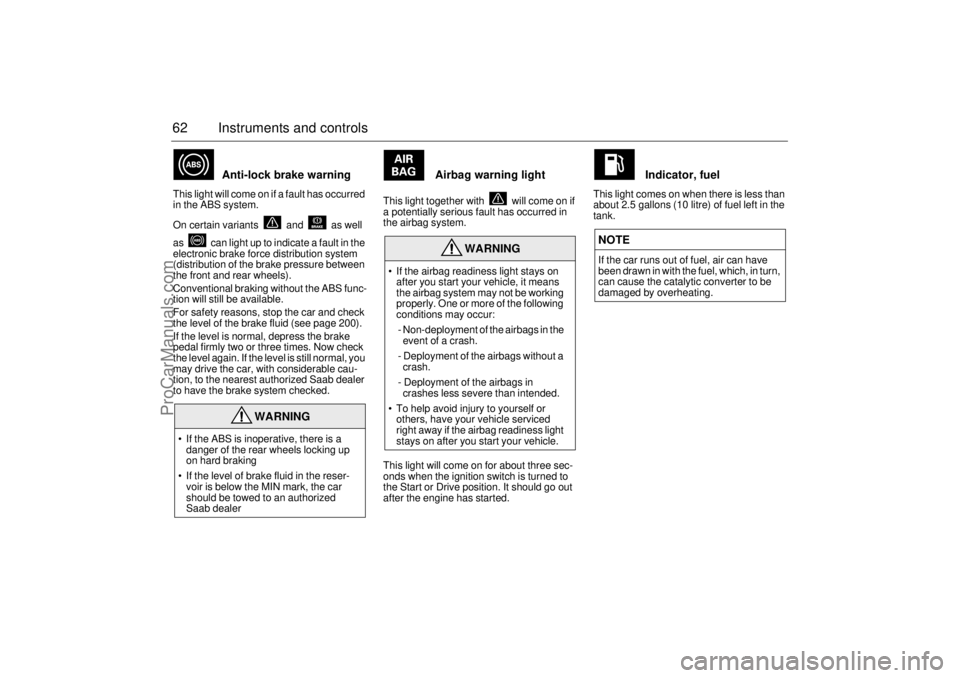
62 Instruments and controls
Anti-lock brake warning
This light will come on if a fault has occurred
in the ABS system.
On certain variants and as well
as can light up to indicate a fault in the
electronic brake force distribution system
(distribution of the brake pressure between
the front and rear wheels).
Conventional braking without the ABS func-
tion will still be available.
For safety reasons, stop the car and check
the level of the brake fluid (see page 200).
If the level is normal, depress the brake
pedal firmly two or three times. Now check
the level again. If the level is still normal, you
may drive the car, with considerable cau-
tion, to the nearest authorized Saab dealer
to have the brake system checked.
Airbag warning light
This light together with will come on if
a potentially serious fault has occurred in
the airbag system.
This light will come on for about three sec-
onds when the ignition switch is turned to
the Start or Drive position. It should go out
after the engine has started.
Indicator, fuel
This light comes on when there is less than
about 2.5 gallons (10 litre) of fuel left in the
tank.
WARNING
If the ABS is inoperative, there is a
danger of the rear wheels locking up
on hard braking
If the level of brake fluid in the reser-
voir is below the MIN mark, the car
should be towed to an authorized
Saab dealer
WARNING
If the airbag readiness light stays on
after you start your vehicle, it means
the airbag system may not be working
properly. One or more of the following
conditions may occur:
- Non-deployment of the airbags in the
event of a crash.
- Deployment of the airbags without a
crash.
- Deployment of the airbags in
crashes less severe than intended.
To help avoid injury to yourself or
others, have your vehicle serviced
right away if the airbag readiness light
stays on after you start your vehicle.
NOTEIf the car runs out of fuel, air can have
been drawn in with the fuel, which, in turn,
can cause the catalytic converter to be
damaged by overheating.
ProCarManuals.com
Page 63 of 260
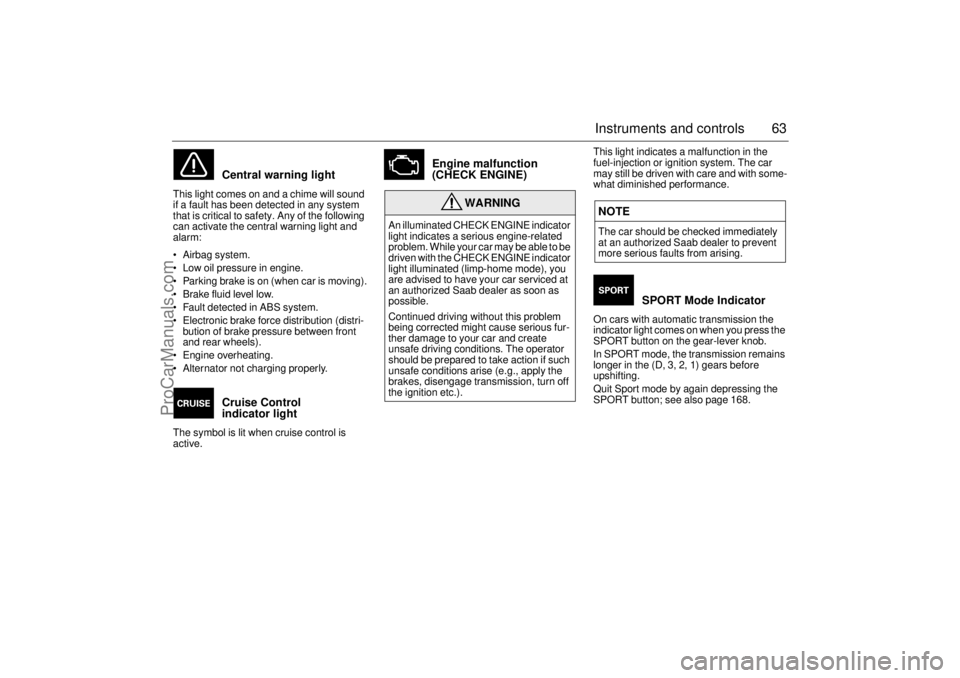
63 Instruments and controls
Central warning light
This light comes on and a chime will sound
if a fault has been detected in any system
that is critical to safety. Any of the following
can activate the central warning light and
alarm:
Airbag system.
Low oil pressure in engine.
Parking brake is on (when car is moving).
Brake fluid level low.
Fault detected in ABS system.
Electronic brake force distribution (distri-
bution of brake pressure between front
and rear wheels).
Engine overheating.
Alternator not charging properly.
Cruise Control
indicator light
The symbol is lit when cruise control is
active.
Engine malfunction
(CHECK ENGINE)
This light indicates a malfunction in the
fuel-injection or ignition system. The car
may still be driven with care and with some-
what diminished performance.
SPORT Mode Indicator
On cars with automatic transmission the
indicator light comes on when you press the
SPORT button on the gear-lever knob.
In SPORT mode, the transmission remains
longer in the (D, 3, 2, 1) gears before
upshifting.
Quit Sport mode by again depressing the
SPORT button; see also page 168.
WARNING
An illuminated CHECK ENGINE indicator
light indicates a serious engine-related
problem. While your car may be able to be
driven with the CHECK ENGINE indicator
light illuminated (limp-home mode), you
are advised to have your car serviced at
an authorized Saab dealer as soon as
possible.
Continued driving without this problem
being corrected might cause serious fur-
ther damage to your car and create
unsafe driving conditions. The operator
should be prepared to take action if such
unsafe conditions arise (e.g., apply the
brakes, disengage transmission, turn off
the ignition etc.).
NOTEThe car should be checked immediately
at an authorized Saab dealer to prevent
more serious faults from arising.
ProCarManuals.com
Page 66 of 260
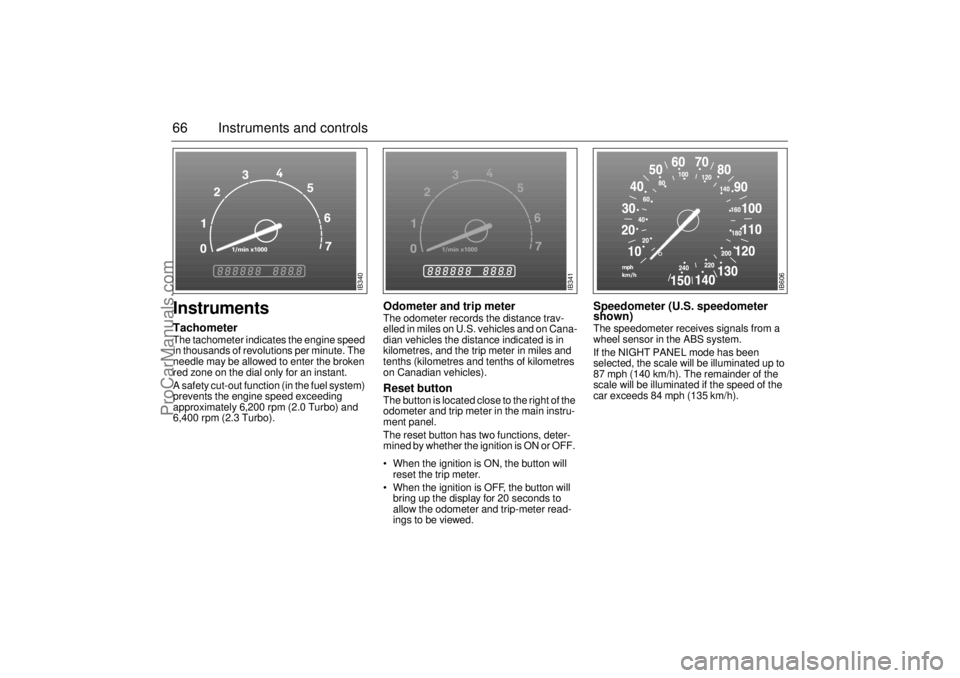
66 Instruments and controlsInstruments TachometerThe tachometer indicates the engine speed
in thousands of revolutions per minute. The
needle may be allowed to enter the broken
red zone on the dial only for an instant.
A safety cut-out function (in the fuel system)
prevents the engine speed exceeding
approximately 6,200 rpm (2.0 Turbo) and
6,400 rpm (2.3 Turbo).
Odometer and trip meterThe odometer records the distance trav-
elled in miles on U.S. vehicles and on Cana-
dian vehicles the distance indicated is in
kilometres, and the trip meter in miles and
tenths (kilometres and tenths of kilometres
on Canadian vehicles). Reset button The button is located close to the right of the
odometer and trip meter in the main instru-
ment panel.
The reset button has two functions, deter-
mined by whether the ignition is ON or OFF.
When the ignition is ON, the button will
reset the trip meter.
When the ignition is OFF, the button will
bring up the display for 20 seconds to
allow the odometer and trip-meter read-
ings to be viewed.
Speedometer (U.S. speedometer
shown)The speedometer receives signals from a
wheel sensor in the ABS system.
If the NIGHT PANEL mode has been
selected, the scale will be illuminated up to
87 mph (140 km/h). The remainder of the
scale will be illuminated if the speed of the
car exceeds 84 mph (135 km/h).
IB340
IB341
IB606
ProCarManuals.com
Page 68 of 260
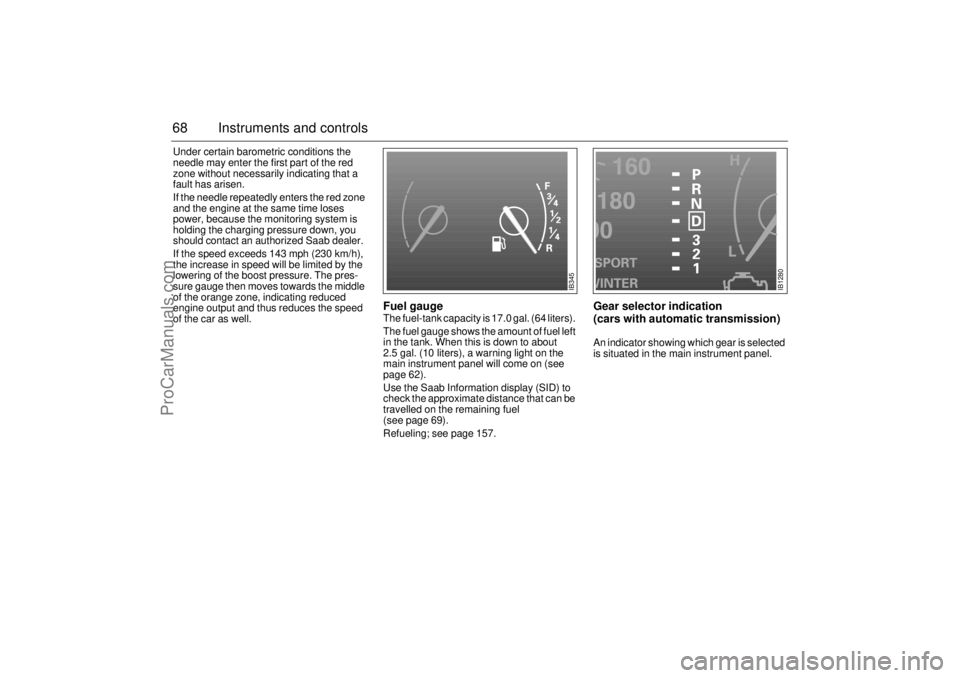
68 Instruments and controlsUnder certain barometric conditions the
needle may enter the first part of the red
zone without necessarily indicating that a
fault has arisen.
If the needle repeatedly enters the red zone
and the engine at the same time loses
power, because the monitoring system is
holding the charging pressure down, you
should contact an authorized Saab dealer.
If the speed exceeds 143 mph (230 km/h),
the increase in speed will be limited by the
lowering of the boost pressure. The pres-
sure gauge then moves towards the middle
of the orange zone, indicating reduced
engine output and thus reduces the speed
of the car as well.
Fuel gaugeThe fuel-tank capacity is 17.0 gal. (64 liters).
The fuel gauge shows the amount of fuel left
in the tank. When this is down to about
2.5 gal. (10 liters), a warning light on the
main instrument panel will come on (see
page 62).
Use the Saab Information display (SID) to
check the approximate distance that can be
travelled on the remaining fuel
(see page 69).
Refueling; see page 157.
Gear selector indication
(cars with automatic transmission)An indicator showing which gear is selected
is situated in the main instrument panel.
IB345
IB1280
ProCarManuals.com
Page 69 of 260
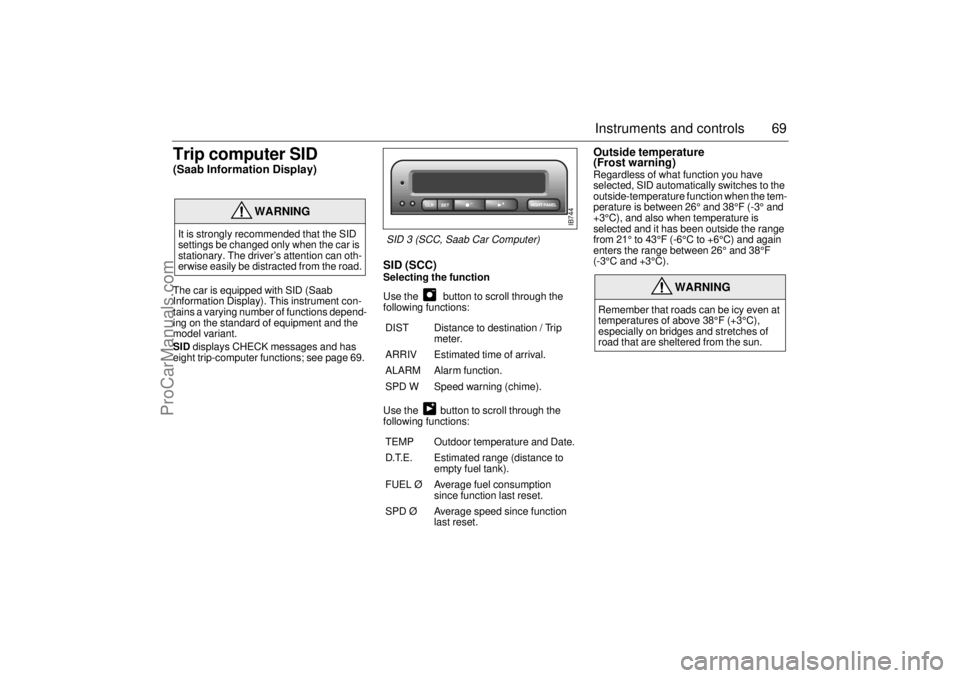
69 Instruments and controls
Trip computer SID(Saab Information Display)The car is equipped with SID (Saab
Information Display). This instrument con-
tains a varying number of functions depend-
ing on the standard of equipment and the
model variant.
SID displays CHECK messages and has
eight trip-computer functions; see page 69.
SID (SCC)Selecting the function
Use the button to scroll through the
following functions:
Use the button to scroll through the
following functions:
Outside temperature
(Frost warning) Regardless of what function you have
selected, SID automatically switches to the
outside-temperature function when the tem-
perature is between 26° and 38°F (-3° and
+3°C), and also when temperature is
selected and it has been outside the range
from 21° to 43°F (-6°C to +6°C) and again
enters the range between 26° and 38°F
(-3°C and +3°C).
WARNING
It is strongly recommended that the SID
settings be changed only when the car is
stationary. The driver’s attention can oth-
erwise easily be distracted from the road.
DIST Distance to destination / Trip
meter.
ARRIV Estimated time of arrival.
ALARM Alarm function.
SPD W Speed warning (chime).
TEMP Outdoor temperature and Date.
D.T.E. Estimated range (distance to
empty fuel tank).
FUEL Ø Average fuel consumption
since function last reset.
SPD Ø Average speed since function
last reset.
WARNING
Remember that roads can be icy even at
temperatures of above 38°F (+3°C),
especially on bridges and stretches of
road that are sheltered from the sun.
IB744
SID 3 (SCC, Saab Car Computer)
ProCarManuals.com